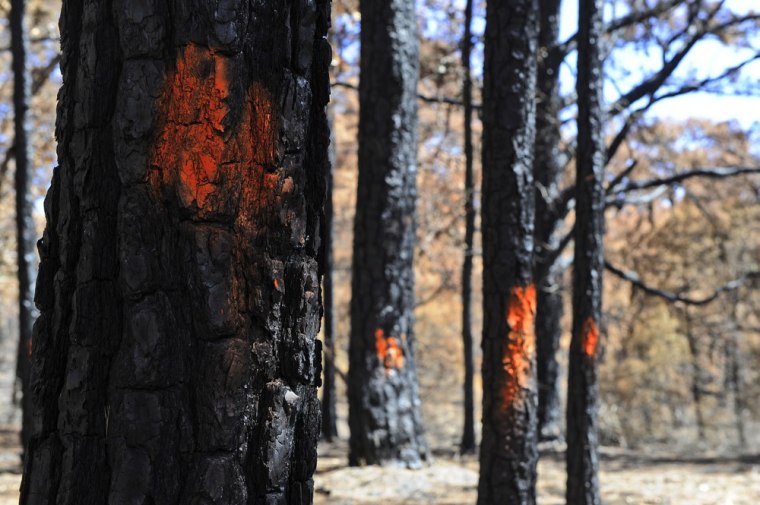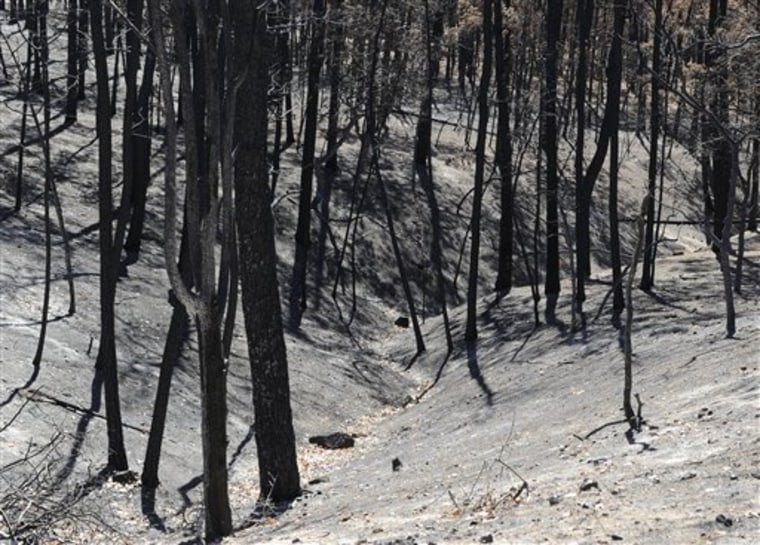Todd McClanahan surveys the fire-blackened tree trunks poking out of a thick carpet of ash, a normally green world turned black and gray.
"You should have seen it in color," says McClanahan, superintendent of Bastrop State Park, mentioning a phrase repeated in Jamey Johnson's award-winning country song "In Color."
The park, one of the most popular in Texas, was ravaged when wind-whipped wildfires scorched 50 square miles east of Austin last month, destroying more than 1,500 homes and torching swaths of the park's signature "Lost Pines" forest that may never fully recover. Rather than a lush green brush under a canopy of towering pines, McClanahan says much of the 5,900-acre park has become "moonscape" — in some spots, for as far as the eye can see.
"It's really kind of depressing," McClanahan says as he evaluates the park's remains from his pickup truck.
More than a month after the inferno, the extent of the damage is still being determined, but McClanahan estimates about 70 percent of the trees in the park were lost.
Texas Parks and Wildlife Department crews are clearing burned tree trunks away from roads and campsites and hiking trails so when the park reopens — tentatively set for December — the threat of falling trees in areas frequented by visitors will be minimized.
"This park is still a significant place," McClanahan says. "It's just going to look different. It's going to feel different.
"In some areas, it's going to take a really long time ... and it may not ever return to what it was."
There are some small signs of recovery. A couple weeks ago, McClanahan was "out in the middle of the black," as he calls it. "There was nothing around except dead standing snags, and I looked down and there was an oak tree that's re-sprouting, almost 18 inches tall," he says.
"But this is the 'Lost Pines.' And that's what's kind of uncertain."
The park's signature forest, a draw for the 160,000 people who visit Bastrop each year, was a unique stand of loblolly pines related to but genetically different from the great East Texas pine forest that extends into the Southeastern United States. The loss of those trees is particularly painful.
"A significant part of 'Lost Pines' is lost," McClanahan said. "And that's a fact."
The "Lost Pines," according to the Texas State Historical Association, are believed part of an ancient forest that shrank during or after the Ice Age. Spanish explorers described it in 1691, and the area that is now the state park was part of the original 1832 land grant to Stephen F. Austin's first colony.
Extensive logging took place in the later 1800s and when land for the park was acquired, the Civilian Conservation Corps built cabins and other park facilities during the Great Depression that are still used today.
Volunteers and private companies with water trucks saved all 13 cabins during the wildfires that began Labor Day weekend, leaving a kind of green oasis in the middle of the park. The fire burning away thick undergrowth revealed features like retaining walls, old latrines and water fountains that no one knew existed.
"You can walk out and see things you've never seen before," McClanahan said. "I don't want to sound morbid ... but there's a beauty in this, in its own strange way. You see things. It's just different. It provides a different opportunity to see the forest in ways you've never seen before."

Some people with good intentions already are pushing to plant pine seedlings to rebuild the burned forest, he said, but a pine tree isn't necessarily a "lost pine" tree. A Texas Forest Service seed farm is the only large-scale source for the trees specific to Bastrop State Park, and trees in the numbers that would be necessary are only in seed form.
"At best, we're looking at 15 months out to have a seedling-size tree to plant," McClanahan said. "And even if we had an abundance of seedlings right now, I'm not sure this is the best time to be planting, based on dry conditions."
In 2008, more than 50,000 such seedlings were planted in the park. Abundant moisture and prescribed burns provided ideal conditions for growth.
"After that fall, it started drying up," he said. "It just didn't rain any more.
"We lost every one of those seedlings."
Troyanne Bush of the Bastrop Chamber of Commerce expects the damage to the park will also bring an economic loss to the area, at least for a while.
"As far as long-term effects, there's really no way to gauge right now," she said. "Traffic hasn't been lighter, but you have to understand we've had a lot of people help with rebuilding efforts. We've got tons of volunteers. The activity is different. If anything, it's greater, but it's a different crowd."
